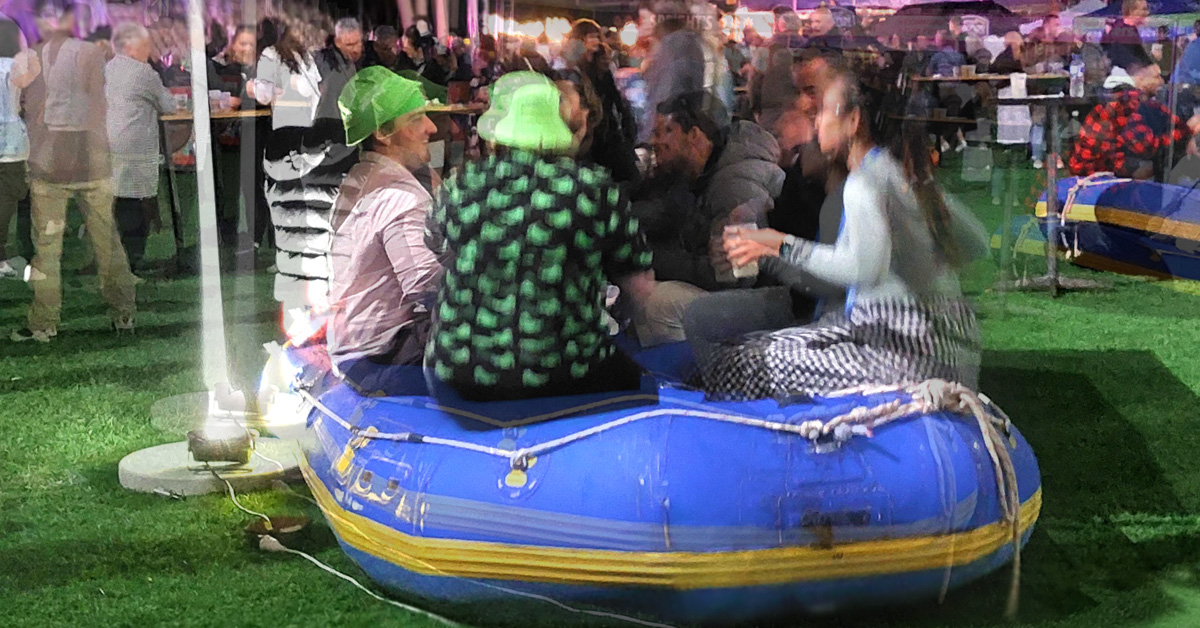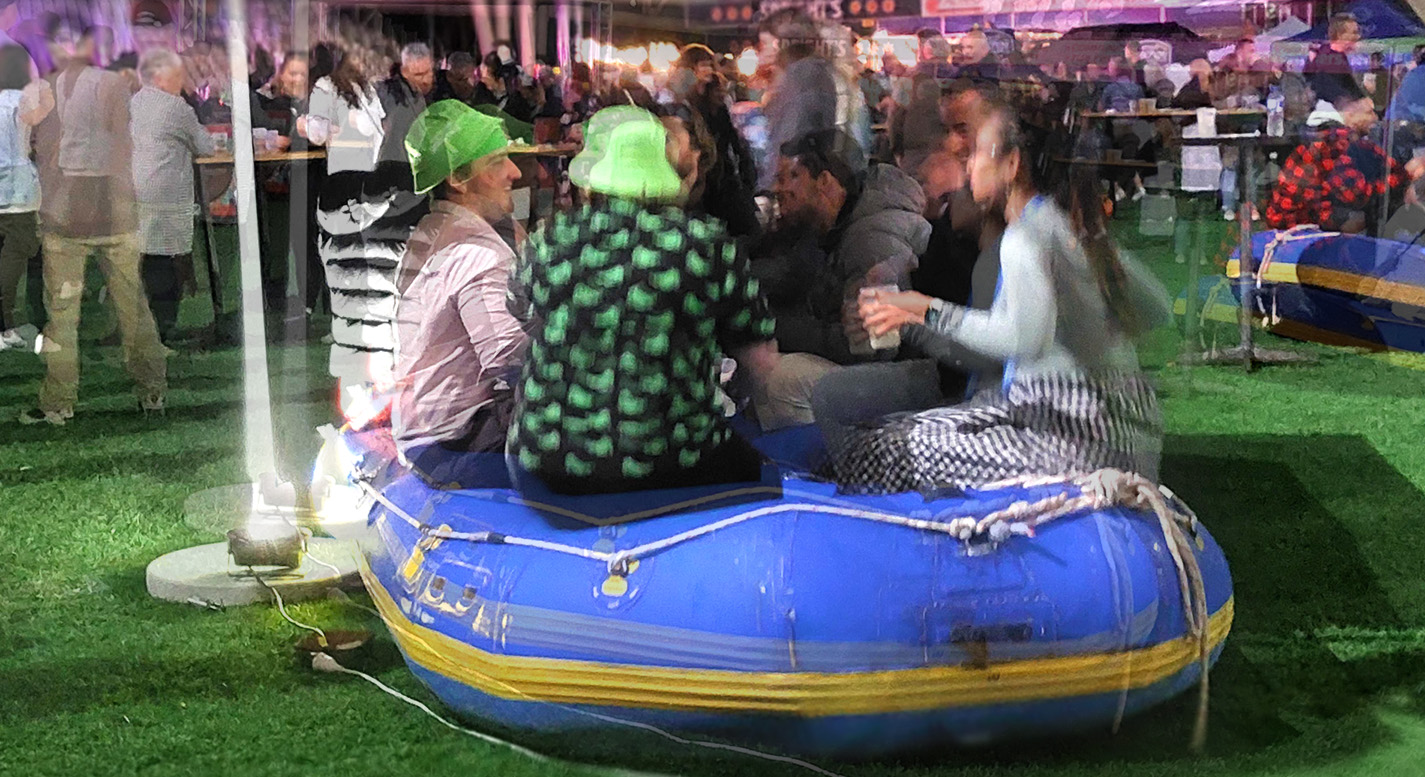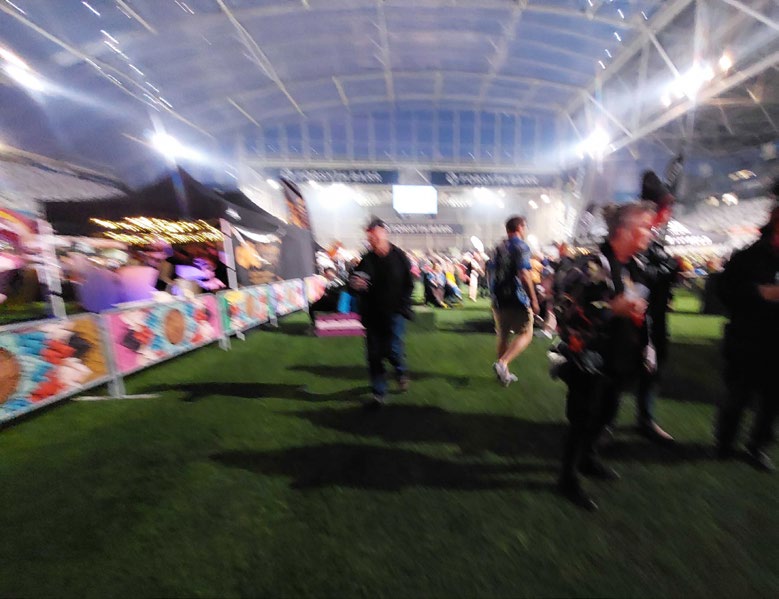
Culture Etc.

OUSA started the festival to fund its operations and to smooth over the relationship between students and the wider city after a series of riotous drinking events.
Beer and Loathing in Dunedin
A former scarfie reacquaints himself with Ōtepoti’s drinking scene and descends into an existential crisis.
Story and tipsy photographs by George Driver
Looking out over Dunedin’s Forsyth Barr Stadium, as a crowd of inebriated southerners rowdily sang in unison “Why does love do this to me?” I was asking myself a different question: Why am I here?
As a relatively new father spending his first night away from his family alone and tipsy at the Dunedin Craft Beer & Food Festival, the answer wasn’t obvious. Everyone else was here to have a good time with friends, a goal at which they appeared to be succeeding. As a journalist, I was here to work, to find an angle, to find answers. I just didn’t know what the question was. It’s by no means a novel conundrum for a journalist. If you went back 2000 years to a gladiatorial duel at the Colosseum, I’m sure you’d find a scribe sitting at the back wondering how to spin something profound out of what he was seeing. At least the scribe had a fight to the death to work with. I just had beer.
Fortunately, I like beer, and the Dunedin Craft Beer & Food Festival is one of the biggest booze-ups in the deep south. The event has clocked up 10 years, and annually attracts about 12,000 punters over two days, and dozens of breweries from around the country.
The festival is run by the Otago University Students’ Association (OUSA) which, on reading the ticket price, was a fact I greeted with some scepticism. It costs $50 to enter and another $8 or so for a beer. Attending a tasting session costs $20. Students get a $5 discount, but when I was a student at Otago 15 years ago, we’d usually only be able to afford a $6 six pack of Southern Draught and a night out consisted of $5 jugs and $3 doubles. My first question: How can students afford to be here?
OUSA events manager Jason Schroder has been running the festival for the last five years. When I spoke to him before the festival, he explained that it’s not really for first-year students. The festival was actually started because of former Act MP Heather Roy. In 2011, Roy’s Education (Freedom of Association) Amendment Bill became law, ending compulsory student union membership and threatening the future of student services around the country as membership levies dried up. In response, the OUSA started looking for a money maker. The concept of starting a beer festival came from an Otago Master of Marketing thesis. Schroder concedes the event is beyond the budget of most undergrad students, but says it’s a boon for the student body. “The main reason was to create a longterm sustainable income stream that would be able to finance the majority of our other student endeavours,” he says. “That was more important to us than putting on something that students can attend.””
The association also hoped putting on an event for the city at large would help ease tensions between students and the city’s permanent residents. During my time at Otago, student riots related to annual events like the Undie 500 rally race and the Hyde Street Party were frequently in the headlines. To smooth things over, OUSA decided to invite the city at large over to North Dunedin for a beer or two. Now, it is the city’s drinking over two days that helps fund the student association’s worthy services.
It’s been an enormously successful endeavour. The first event attracted around 3500 people and was held on a small concrete slab in one section of Forsyth Barr Stadium. It’s now grown to fill the entire pitch, and tickets usually sell out within minutes. The festival now has spinoffs in Hawke’s Bay and Auckland, also bringing in revenue for the association.
I was eager to discover how Dunedin’s beer scene had changed since my six-year tenure in the city. Back then, the main local beer we’d drink was from a brewery called McDuffs on Great King Street. It was originally called Duffs Brewery, named after founder Gavin Duff, but The Simpsons featured a fictional beer of the same name and it had to be renamed after pressure fromTwentieth Century Fox. The beer wasn’t particularly good, but it was cheap. Their $150 kegs fueled many a house party in North Dunedin.”
My festival began with the perfect reintroduction — a “Taste of Dunedin” tasting session, with eight beers from four local breweries, held in a corporate function room in the bowels of the stadium. I discovered the city’s beer scene had transformed for the better. The beers were as eclectic as their brewers — who included a former banker, a baker and a builder — with styles ranging from hazy sour pale ales to a coconut-infused desert stout.
Outside, the festival was already in full swing. I had been sceptical of the ambience created by 12,000 people drinking in a sports stadium, but with an enclosed roof offering shelter from the gale outside, it was the warmest place in the city. People were playing table tennis, drinking in inflatable life rafts and slumped on old furniture arranged to look like a student flat. At one end of the field, people sang karaoke to the Spice Girls. At the other, bands from around the country played throughout the night. There was also a lot of lederhosen. No one mentioned the C-word — Covid-19.”
My next memory is of slipping into a monologue about myself, talking to a journalist who I had just met. He soon made his excuses, never to be seen again.

The OUSA has promoted the festival as a way to change New Zealand’s drinking culture and to “educate people about making wise decisions about alcohol”.
Circling the beer stands, I soon became paralysed by choice. While a decade ago it was difficult to walk into an Otago bar and get served anything other than Speights, now I find the typical tap selection to be overwhelming. Here, at the festival, roughly 400 beers were available.
My strategy to navigate this sea of choice was to focus on the breweries’ Belgian-style beers. For the last decade, many New Zealand craft breweries have been in pursuit of hoppiness, competing to reach numbing levels of bitterness. I was party to this pursuit at first and believed the hoppier the better, but after moving to Belgium for a year, I converted to their centuries-old approach.”
In Belgium, hops are used sparingly and take a back seat to yeast, which provides most of the flavours. Their beers are often brewed at high temperatures in open vats to stress the yeast and even encourage bacterial infections to provide sourness, the kind of conditions most brewers assiduously avoid. Adjuncts like orange peel and coriander seeds are also added and the beers are often barrel-aged. In general, they’re eye-wateringly strong, regularly exceeding eight per cent alcohol by volume. But it all creates an intensity of flavours — citrusy, malty, sweet but balanced — that serves as the perfect antidote to the country’s grim winters.”
While still rare in New Zealand, Belgian styles are becoming more common among craft breweries and I seek them out where I can. Craftwork in Oamaru is entirely dedicated to Belgian brews, and the founders actually run beer tours to Belgium. Their tasting room in Oamaru’s Victorian precinct is like stepping into a traditional Belgian beer bar, complete with chequered floors and stained-wood panelling. My first call for the day was their saison — a traditional farmhouse style that’s spicy yet refreshing. This was followed by a tart and crisp Flemish red ale dubbed Erik the Red from Dunedin’s newest nano brewery, Dogstar Brew Lab. But I was soon in for my greatest Belgian beer experience outside of Flanders.
I returned to the sterile corporate cavern of the tasting lounge for a session led by Richard Emerson, the man who has done more for Dunedin’s beer than anyone else, James Speight included. In 1992, after travelling overseas and discovering that beer didn’t have to be bland bubbly brown ales, Emerson returned to the city and started Emerson’s Brewery. He aimed to replicate the styles he found in Europe and to convince Dunedin drinkers that there was more to beer than Speights. He took the hard route.
Emerson’s first commercial brew was a porter, served warm and flat from bespoke wooden barrels and poured from a hand-pump. Emerson’s pilsner later spawned an international style of its own, the now ubiquitous New Zealand pilsner — a clean pilsner showcasing Nelson’s fruity hops abundance. While the brewery is now renowned for hoppy beers, Richard Emerson explained that his favourite brews were the yeasty beers of Belgium. Since 2007, Emerson’s (now owned by Lion) has released a Belgian-style ale, the JP, commemorating Belgian brewing scientist Jean- Pierre Dufour, who worked at the University of Otago and helped the brewery in its early years. Dufour died in 2007 and Emerson’s has released a Belgian-style JP on his birthday ever since.
The tasting focused on aged beers from 30 years of Emerson’s, including two delicious spiced ales and an oyster stout. But the main event for me were two Belgian-styles. The first was the latest JP brew, a Belgian quad — a dark beer that has roughly four times the malt of a regular ale and weighs in at about 10.5 per cent ABV — which was extraordinary, tart and fruity. The second was Emerson’s Deafinition (Richard’s deaf) barley wine. Made in a 200-litre batch and served in a 750ml champagne bottle with a cork, Emerson said the 10.5 per cent ale was his favourite Emerson’s beer. I visited half a dozen Belgian breweries during my time in Europe, and these two beers were among the best I’ve tried.
I was in the dimly lit function room for over an hour, working my way through the selection. While the tasting samples seemed unassuming, I later calculated that their high octane was probably the equivalent to drinking four or five glasses of wine (was I meant to swizzle and spit?). My next memory is of slipping into a monologue about myself, talking at a journalist from another New Zealand publication who I had just met. He soon made his excuses, never to be seen again.
Back outside, the atmosphere had changed, taking on a rabid energy. The Jordan Luck Band began running through their hits on the main stage and shouting was now the favoured form of communication, creating a deafening buzz. The booze then began to nibble into my journalistic confidence. What was I meant to be doing and why was I here? It seemed like I’d just been drinking beer, but this was meant to be work.
By this time, the winners and losers of the festival were beginning to emerge. It was like capitalism at its most brutal and personal — or so I wrote on my phone at the time in a state of booze-fueled hyperbole. It seemed not everyone was as enamoured with the Belgian brews on offer. Craftwork Brewery was already starting to pack up when I sidled over. “Everyone just wants hazies,” the stallholder sighed.
Curiously, the once-popular pioneer craft breweries from Auckland and Wellington were likewise deserted. But the Dunedin breweries seemed to have a queue the entire night. I managed to corner Jono Walker from the excellent Arc Brewery based in Blueskin Bay, north of the city (and who I went to school with, incidentally). However, I managed to immediately delete the recording of our 10-minute conversation and the interview is now lost to history. It was clearly time for this tipsy hack to head to bed.
All of the stalls were by then closing in any case. I stationed myself near the exit, watching those even worse for wear disgorge from the stadium. Other than one woman vomiting into her festival glass, it was a slow but well-behaved exit.!On the walk back to my Great King St hotel, I went through the deserted university and past the empty student pubs of my youth. Sal’s Pizza, in the former Cook tavern, was however filled with middle-aged festival punters like myself, soaking up the beer before concluding a rare night out and going home to relieve the babysitter, or so I surmised.
I retreated to my hotel room to watch pay TV until midnight, basking in the final minutes of life on the road without the family. I awoke alone and bleary eyed, my voice an octave lower. I had not slept well. I made one last stop on the way out of town to buy a bottle of Emerson’s JP, before heading back home to my family in Clyde.
George Driver is North & South’s South Island correspondent, a role made possible by New Zealand On Air’s Public Interest Journalism funding. He was a guest of OUSA.

This story appeared in the February 2023 issue of North & South.
